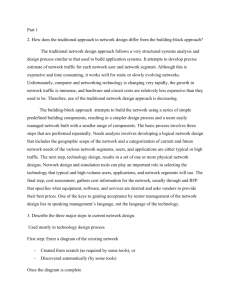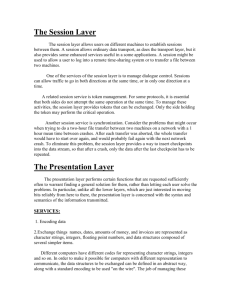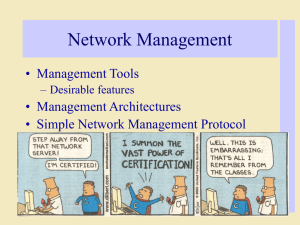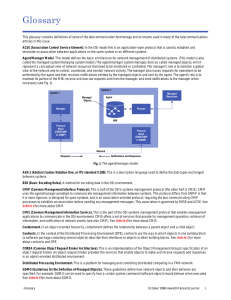Design and Implementation of New Architecture to Improve Gholamreza Farahani
advertisement
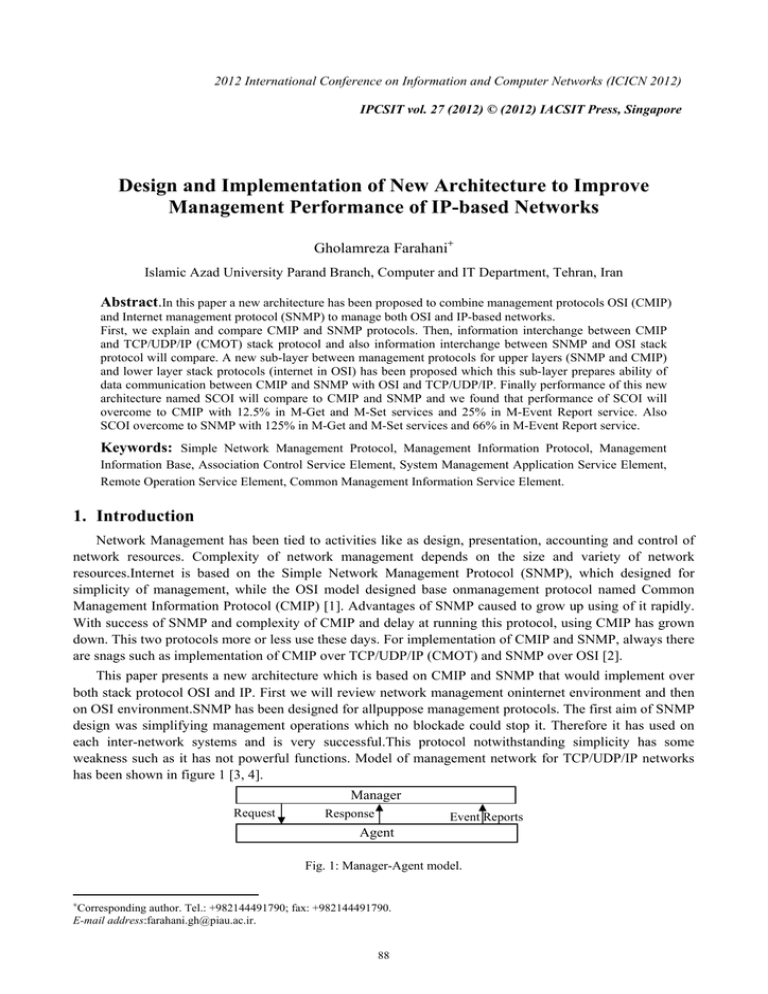
2012 International Conference on Information and Computer Networks (ICICN 2012) IPCSIT vol. 27 (2012) © (2012) IACSIT Press, Singapore Design and Implementation of New Architecture to Improve Management Performance of IP-based Networks Gholamreza Farahani+ Islamic Azad University Parand Branch, Computer and IT Department, Tehran, Iran Abstract.In this paper a new architecture has been proposed to combine management protocols OSI (CMIP) and Internet management protocol (SNMP) to manage both OSI and IP-based networks. First, we explain and compare CMIP and SNMP protocols. Then, information interchange between CMIP and TCP/UDP/IP (CMOT) stack protocol and also information interchange between SNMP and OSI stack protocol will compare. A new sub-layer between management protocols for upper layers (SNMP and CMIP) and lower layer stack protocols (internet in OSI) has been proposed which this sub-layer prepares ability of data communication between CMIP and SNMP with OSI and TCP/UDP/IP. Finally performance of this new architecture named SCOI will compare to CMIP and SNMP and we found that performance of SCOI will overcome to CMIP with 12.5% in M-Get and M-Set services and 25% in M-Event Report service. Also SCOI overcome to SNMP with 125% in M-Get and M-Set services and 66% in M-Event Report service. Keywords: Simple Network Management Protocol, Management Information Protocol, Management Information Base, Association Control Service Element, System Management Application Service Element, Remote Operation Service Element, Common Management Information Service Element. 1. Introduction Network Management has been tied to activities like as design, presentation, accounting and control of network resources. Complexity of network management depends on the size and variety of network resources.Internet is based on the Simple Network Management Protocol (SNMP), which designed for simplicity of management, while the OSI model designed base onmanagement protocol named Common Management Information Protocol (CMIP) [1]. Advantages of SNMP caused to grow up using of it rapidly. With success of SNMP and complexity of CMIP and delay at running this protocol, using CMIP has grown down. This two protocols more or less use these days. For implementation of CMIP and SNMP, always there are snags such as implementation of CMIP over TCP/UDP/IP (CMOT) and SNMP over OSI [2]. This paper presents a new architecture which is based on CMIP and SNMP that would implement over both stack protocol OSI and IP. First we will review network management oninternet environment and then on OSI environment.SNMP has been designed for allpuppose management protocols. The first aim of SNMP design was simplifying management operations which no blockade could stop it. Therefore it has used on each inter-network systems and is very successful.This protocol notwithstanding simplicity has some weakness such as it has not powerful functions. Model of management network for TCP/UDP/IP networks has been shown in figure 1 [3, 4]. Manager Request Response Event Reports Agent Fig. 1: Manager-Agent model. + Corresponding author. Tel.: +982144491790; fax: +982144491790. E-mail address:farahani.gh@piau.ac.ir. 88 The management model has components namely Manger entity, Agent entity, Management Information Base (MIB) and Management Protocol between two entities (SNMP). Management protocol of simple network should be designed such that includes application levels. For implementation of SNMPat fourth layer of network, User Datagram Protocol (UDP) will use. SNMP will sit over UDP which is connectionless protocol, therefore SNMP is also connectionless. Behalf of manager entity, three management message named: Get Request, Get Next Request and Set Request will send for agent entity. Response of these messages is Get Response service that will answer with agent entity. Therewith, it might be agent entity for an event at management database, send an Event Report service. In figure 2 SNMP architecture has drawn [5]. Managed application SNMP Manager UDP IP Data link and Physical Network SNMP Messages Managed Object SNMP Agent UDP IP Data link and Physical Network Fig. 2: SNMP architecture. Management structure of OSI is like as SNMP, which is made from some component that together provide management capability. These components are named manager entity, agent (managed) entity, management connection protocol CMIP and Management information base [3, 6]. Protocol characteristic of CMIP, implicates a precise protocol includes connection, disconnection and sending management messages. Figure 3 shows a layering structure of management system for CMIP protocol. Key elements of this architecture are Association Control Service Element (ACSE), System Management Application Service Element (SMASE), Remote Operation Service Element (ROSE) and Common Management Information Service Element (CMISE). System management application service element (SMASE) Common Management Information Service Element (CMISE) Association Control Service Element (ACSE) Remote Operation Service Element (ROSE) Presentation Layer Fig. 3: Management structure of application layer at CMIP protocol. ACSE element will use to connect and disconnect link by user. To carry out these tasks, there are services that havebeen standardized by ITU-T. At CMIP for connection establishment and disconnection, these services have used with simplicity. In standard for services of this element two condition of connection-oriented and connectionless have been considered. SMASE element has different structure in comparison with other elements. For this functional element, there is not clear rules and standard. This element is made of some System Management Functions (SMF). Some samples of these functions are: Alarm report, Alarmdeclaration, Alarm abstracting and etc. ROSEfunctional element will use for sending a request to a remote system and receiving a corresponding response. This element, defines a standard structure for sending request and receiving corresponding response. CMISE element includes services and protocols for better clearance of request and response structure which provide with ROSE element. With using services and protocols of this element, all management information will transfer to functional element ROSE and result (request or response) will be sent. As we 89 know, many models implemented on the IP network protocol [7, 8] but in this paper we concentrate on the increasing performance of IP-based networks. 2. Comparison CMIP with SNMP CMIP and SNMP each of them has some advantages and weaknesses. Selecting one of them depends on the many parameters. The main advantage of SNMP is simplicity in design, also SNMP will use when a number of communicated messages between manager and agent entities are low. The main weakness of SNMP is low security which is now better at new versions. Because of using connectionless services in transport layer, agent entity will not receive acknowledge, therefore it can not sure that its alarm report reached to manager entity. Thus when there is huge management information for communication, the network traffic load will be more and may be management information lost. On the other hand, CMIP has designed to compensate the lacks of SNMP and it could be used for lager networks. In design and implementation of SNMP, it has used an object-oriented model [9]. The main advantage of CMIP is defining the techniques to cover manual control, security and filtering of management information. The main disadvantage of CMIP is occupying resources for more time than SNMP. Finally in table 1, we listed the services of CMIP and SNMP protocols. Table 1. CMIP and SNMP services. Name Valid Service(s) Description GET CMIP and SNMPObtain a value maintained by the managed object. SET CMIP and SNMPSet a value maintained by the managed object. EVENT-REPORTCMIP and SNMPRepot special conditions about a managed object. GET NEXT SNMP Determine the name and value of the next SNMP attribute in the object. ACTION CMIP Invoke one of the actions defined for the managed object. CREATE CMIP Create an instance of an object class. DELETE CMIP Delete an instance of an instance class. 3. New architecture for network management in the combined OSI and TCP/UDP/IP environment As discussed, CMIP and SNMP each could implement on the OSI and TCP/UDP/IP separately. In our new architecture, we proposed management for both OSI and TCP/UDP/IP networks simultaneously. As shown in figure 4, this new architecture could manage hybrid OSI and Internet-based networks. We named this new architecture SCOI (SNMP and CMIP Over Internet). This model means: • CMIP could manage both OSI and TCP/UDP/IP networks. • SNMP could manage both OSI and TCP/UDP/IP networks. • Some parts of operation carry out by CMIP and other parts by SNMP. Protocol selection to manage network depend on the parameters such as network size, network traffic, resource accessibility and required management functions. In table 2, Management functional areas of CMIP and SNMP have been compared. For implementation of SNMP on the OSI, a selector defines. Selector “snmp” is used for management and “snmp trap” for declaring alarm. Manager or agent SNMP entity will recognize type of message with listening to this selector. For putting CMIP on the TCP/UDP/IP, Low Presentation Protocol (LPP) for connection of TCP/UDP/IP to upper layers in OSI model is proposed. This sub-layer will present important functions of CMIP on the stack protocol TCP/UDP/IP and also required function of SNMP on the OSI protocol stack. 90 OSI MIB Internet MIB CMIP SNMP Definition of the new transport selectors RFC 1283 Lightweight Presentation Protocol (LPP) RFC 1085 The Hybrid Mapping Layer (SCOI) OSI TCP/IP Fig. 4: Proposed architecture of network management. Table 2. Functional management of SNMP and CMIP. Management Functional Areas Configuration Management Fault Management Detecting and reporting faults Diagnosing fault Correcting fault Security Management Performance Management Monitoring performance Tuning and controlling performance Reporting on performance, monitoring, tuning and tracking Testing capacity and special conditions Accounting Management SNMP X CMIP X X X X X X X X X X 4. Performance Calculation To asset performance of our new proposed architecture, first we calculate the passing time for receiving response after sending a request.For calculation of performance, we used a two Pentium 4, 2.4 GHz for manager and agent entities and instead of real network element; we used simulator software for network element. For three different types of services, time calculation is carried out as follow: M-Get service: manager entity will send an M-Get request and agent entity will response to this request. We measure passing time between sending request and receiving response. M-Set service: manager entity will send an M-Set request and agent entity will response to this request. The passing time between sending request and receiving response will measure. M-Event Report service: network simulation software will send an alarm and agent entity will send an M-Event report to the manager entity. At manager entity, we measure time between consecutive M-Event Report. In figure 5, the results of these measurements have shown. As shown in figure 5, the number of operations per second has been calculated and proved that SCOI shown in figure 4 has a better performance than CMIP with 12.5% in M-Get and M-Set services and 25% in M-Event Report service. For SNMP compare to CMIP, we get a better improvement in performance as 125% in M-Get and M-Set services and 66% in M-Event Report service. 91 5000 4000 M-Get Ops/sec 3000 M-Set 2000 M-Event Report 1000 0 SCOI CMIP SNMP Architecture type Fig. 5: Comparing Performance of three models. 5. Conclusion In this paper, a new architecture for management of hybrid OSI and Internet network proposed. This architecture named SCOI is based on CMIP and SNMP protocols to manage computer networks.Also a new sub-layer between upper layer management protocols and protocol stacks OSI and TCP/UDP/IP designed. With use of this sub-layer, CMIP and SNMP will prepare required services of OSI and internet which is independent of lower layers protocols.This new architecture has designed for fast communication between manager and agent entities without lower layer dependency. SCOI overcomes to CMIP and SNMP separately in the performance. Results show improvement in performance in comparison to CMIP and SNMP. 6. References [1] Lakshmi G.Raman, Fundamental of Telecommunication Network Management, IEEE press, New York, 1999. [2] Common Management Information Services and Protocols for the Internet (CMOT and CMIP), RFC 1189, ITU-T Recommendation X.711, 1990. [3] Principles for a Telecommunications Management Network, ITU-T, M3010, 1996. [4] Mark A.Miller, P.E., Trouble Shooting TCP/IP, Prentice Hall, 1992. [5] TMN Interface Specification Methodology, ITU-T, M3020, 1997. [6] Y.Pouffer, ISO Transport Service on top of TCP (ITOT), RFC2126, Network Working Group, Digital Equipment Corporation, March 1997. [7] Internet Protocol, RFC791, Information Sciences Institute University of southern California, 1981. [8] Stephen A.Thomas, Ipng and TCP/IP protocols, John Wiley & Sons Inc., 1996. [9] Marshall T. Rose, Keith McCloghrie, How to Manage Your Network Using SNMP, Prentice Hall, 1995. 92
